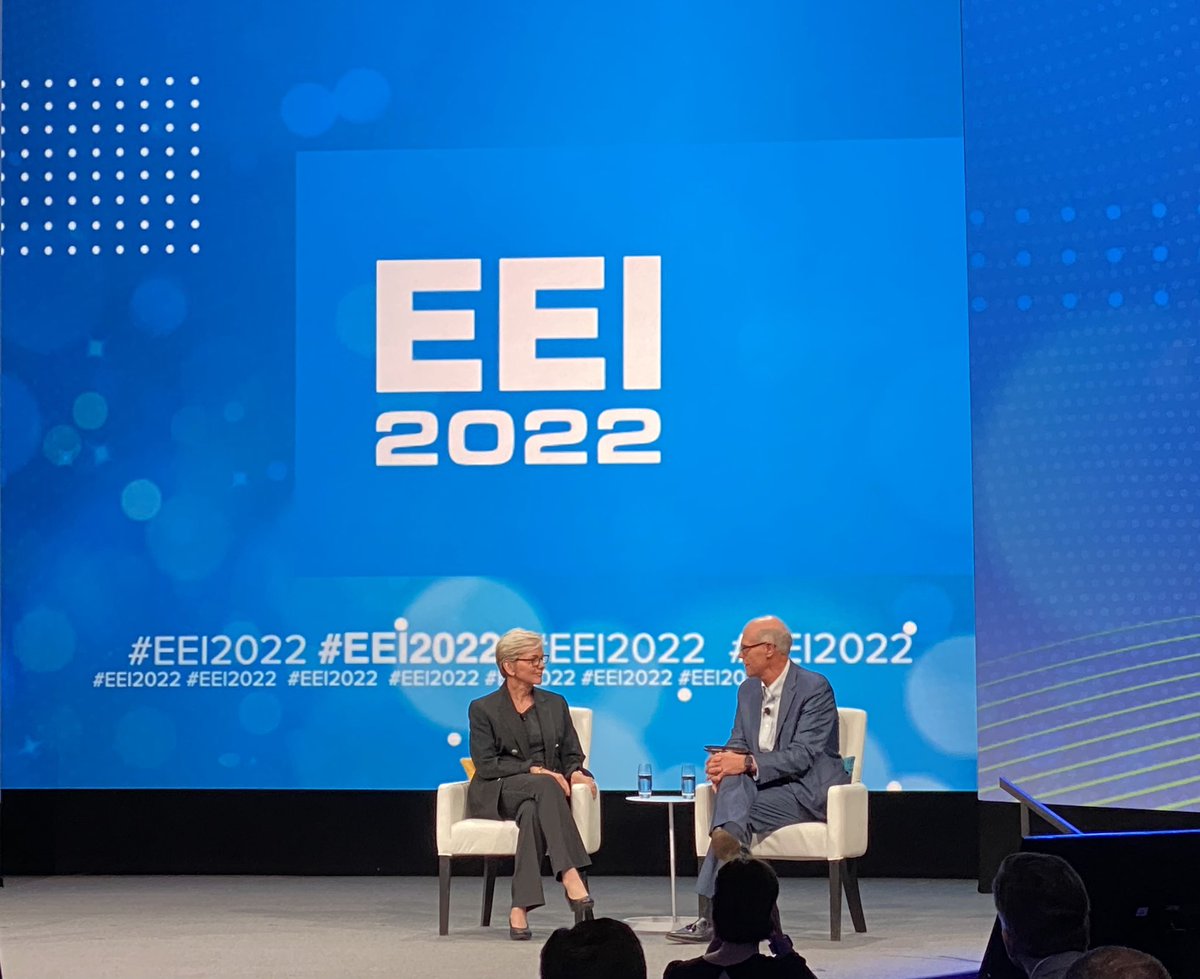Energy Secretary says time is right for clean energy tax credits

Energy Secretary Jennifer Granholm told a meeting of electric utility industry participants on Wednesday that the time is right to marry the Bipartisan Infrastructure Law with clean energy tax credits for the United States to move forward with its clean energy goals.
“The infrastructure law is really the backbone of our energy future and the tax credits are really the lungs,” Granholm said, adding that passage of the Bipartisan innovation Act, which would fund development of the U.S. semiconductor industry, would be considered “the brains.” All three pieces are needed, she said.
Granholm spoke with Warner Baxter, executive chairman of Ameren Corp., at the Edison Electric Institute’s EEI 2022 annual conference in Orlando on Wednesday. Baxter, who is serving as EEI’s newly elected chairman, said the Bipartisan Infrastructure Law (BIL) presents the energy industry with a “once in a generation” opportunity. The BIL’s more than $65 billion for power infrastructure includes the largest investment in clean energy transmission and the grid in U.S. history.
Baxter underscored that clean energy tax credits are “one of our top priorities to get across the finish line because we know it isn’t just about moving the energy transition along more rapidly, but it gets to customer affordability.”
EEI and its member investor-owned electric companies have urged Congress to do even more to address climate change while benefiting electricity customers. Specifically, the organization has called for passing legislation that provides optionality in choosing between the production tax credit (PTC) and investment tax credit (ITC) for solar; alternatives to normalization for regulated electric companies; 100-percent direct pay for the clean energy credits; a nuclear PTC for existing facilities; new tax credits for storage, transmission, and hydrogen; and expansion of the electric vehicle tax credit/EV infrastructure credit.
The industry believes clean energy tax credits are a strong tool in lowering energy prices for utility customers.
“I’m not sure that message has taken hold as much as it could,” Granholm said. “I’m actually though feeling quite optimistic that we will get a version of the tax credits … I think perhaps because of the invasion of Ukraine, and the notion that energy markets are so vulnerable to price volatility… I think there’s a sensitivity now on Capitol Hill about the importance of our energy security by building out our own clean energy future.”
Granholm discussed the need for the United States to invest in the technologies that allow the nation to be free from fossil fuels being weaponized and also more insulated from the volatility of the global fossil fuel market.
“So I think because of that you will see an appetite in this reconciliation bill for these clean energy tax credits as a way for us to become energy independent,” Granholm said.
Building out that energy security would also mean production of energy equipment and supplies in the United States, she added.
In a CEO leadership panel, Ameren’s Baxter joined DTE Energy Executive Chairman Gerry Anderson and Portland General Electric President and CEO Maria Pope in a discussion about the challenges facing the power industry.
Anderson said despite major strides toward clean energy, the industry still has a way to go.
“Many of us have committed to net zero, and a lot of us have looked really hard at the modeling and what that’s going to take,” he said. “The conclusion that you come to pretty quickly is that we’re going to need new technologies. We’re going to make a lot of investments in batteries and solar and wind, but they are not going to get the job done.”
Anderson said technologies like modular nuclear, carbon capture and hydrogen were needed in the mix in order for the industry to reach its carbon emission reduction goals.
Pope, whose Portland, Oregon-based company experienced not only the pandemic, but civil unrest, wildfires and flooding in the years since 2020, said that the last two years have taught energy providers how to react and to react quickly. It also provided the opportunity to accelerate technology transformation.
“The pandemic has taken, what would have been five maybe seven, maybe 10 years of change, and consolidated into two or three years,” she said. “I think we’ll look back on this time as hard – but really important – in accelerating our transformation.”
Baxter said that one of the biggest challenges will be strengthening transmission.
“Transmission is the backbone of our industry,” he said. “(The BIL) gives us the opportunity to invest in transmission… There is no clean energy transition unless we have an investment in transmission.”
The changes in the industry are no more apparent than with the differing attitudes toward electric vehicles, Anderson said.
“There was a time when clean energy was held at arm’s length by the industry, because we weren’t quite sure it could be pulled off successfully,” he said. “It’s fair to say that there was a time not too long ago when the auto industry in America was holding the transition to electric vehicles at arm’s length because they weren’t sure the average cost and technologies would come together to make them successful… now the only conversation in those companies is the transition to electric vehicles.”
The inclusion in the BIL of funding for electric vehicle charging stations will further advance the transition to electric vehicles, Anderson said.
